Our Environmental Day was planned with a week's in-class preparation! Bio2 students were grouped into teams and given various tasks. All worked hard on material preparation and practice. A description follows:
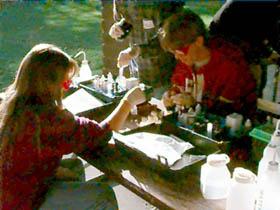
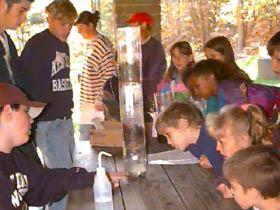
Team 1; All The Water In The World
Team 1 used a trash can with 100 L of water and had kids estimate and measure out predicted amounts for water resources on Earth. Discussed with posters and a groundwater model the water cycle. Collected living "things" to look at under stereoscopes for kids to view later.
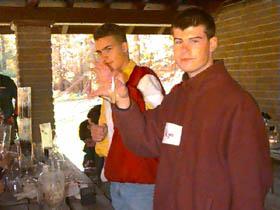
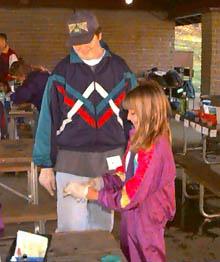
Team 2; Water Cycle Column
Team 2 used Bottle Biology book from Kendall Hunt Publisher to follow directions for a demo with a water cycle column made from 2L bottles. Also used to show how all the water we have stays in the Earth's system; used to demo acid rain! pH paper inside then match lit and introduced to inside, pH paper actually changes color right in front of kids eyes. Demo with ziplock bag and water with BTB the effects of car exhaust or exhale (turns yellow). Responsible for CO2 test kit and results with a 5th grader.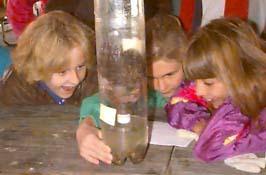
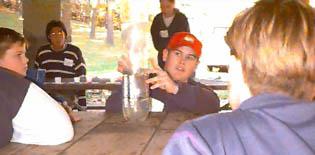
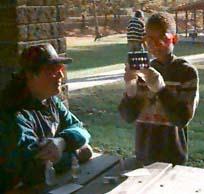
Team 3; pH and Groundwater
Team 3 continued explanation of pH showing range of colors and use of indicators so far. Activity from GEMS What is the Effect of Soil on Acid Rain? Discuss Eastern Kentucky ecology with respect to limestone and ability to neutralize acid ppt. Mostly rigged as a demo to show dramatic color change with soils that can and cannot neutralize "acid rain"...vinegar. Responsible for pH test kit and results with a 5th graderTeam 4; Water Testing Activity
SO FAR, ALL THE 5TH GRADE KIDS IN A SHIFT (15) HAVE BEEN TOGETHER SEQUENTIALLY OBSERVING EACH OF THE THREE TEAMS. NOW 7 KIDS ARE HANDED A CARD WITH A SPECIFIC WATER QUALITY TEST ON IT AND INSTRUCTED TO PAIR WITH THEIR PARTNER (ONE OF THE HIGH SCHOOL KIDS). THEY GO TO THE NEARBY CREEK, SAMPLE, RETURN TO THE PICNIC SHELTER, PUT ON SAFETY EQUIP, AND ARE INSTRUCTED IN THE PROCEDURE FOR ANALYZING THE WATER. RESULTS WERE PUT ON A MASTER DATA TABLE (REALLY BIG) AND SENT BACK TO THEIR SCHOOL. THE OTHER HALF OF THE KIDS WERE PUT IN A TEAM TO MAKE SEVERAL TERRAQUA COLUMNS. THESE WERE MORE 2L CONSTRUCTIONS WHERE THEY COULD MAKE A WICK IN AN UPPER LEVEL TO GO DOWN TO THE "GROUNDWATER LEVEL" AND WOULD TRANSPORT WATER UP TO THE "SOIL LEVEL " AUTOMATICALLY WATERING PLANTS, ETC. THEY COMPLETED THOSE WHILE WATER TESTING CONTINUED, THEN THE 5TH GRADERS LOOKED THROUGH THE MICROSCOPES AND STEREOSCOPES UNTIL ALL WERE ASSEMBLED FOR THE LAST DEMONSTRATION.
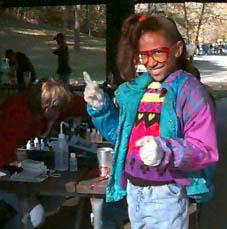
Team 5; Ecocolumn
An ecocolumn was prepared with 5 2L bottles with all kinds of habitats. Kids especially enjoyed the minnows and crayfish caught that morning and placed in the lowest layer! Group demonstrated how all the layers were important (water reservoir, decompostion chamber, plant and animal life chambers, etc.). Kids showed a huge bagful of 2L bottles and all the directions being given to their teachers so they could make them back at school.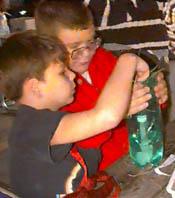
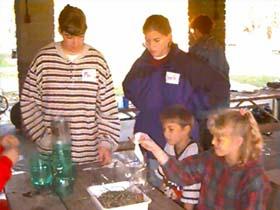
Final Question? What's the best way to make an ecosystem work? COOPERATION!
Kids led to a grassy area and instructed in doing a lap sit! Project Wild activity!
We had about 45 minutes for each shift of 5th graders, so we moved pretty fast
through the activities and demonstrations. After lunch, we got all the kids to
try a big lap sit. 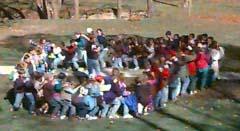
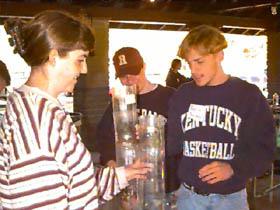
Back to Water Watch Home Page